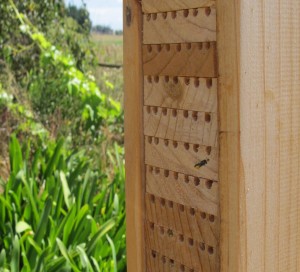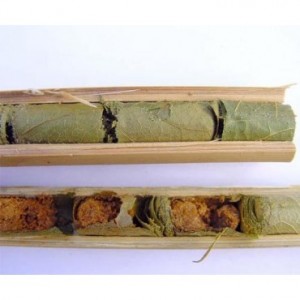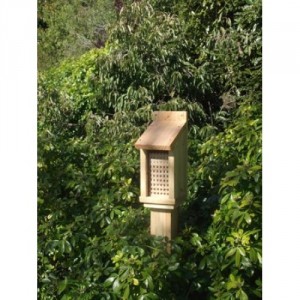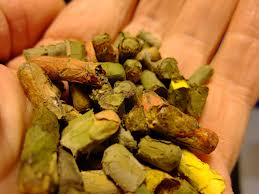Monthly Archives: June 2013
Solitary bees in our own backyards?
Solitary bees in our own backyards?
What’s that green bee flying past? my wife asked
We were enjoying a coffee on the patio and sure enough a few minutes later a bee carrying a rolled up leaf rolled between its legs landed nearby. I had never seen a leafcutter bee before and I had certainly never heard of solitary bees that don’t live in hives.
Since that day www.creativewoodcraft.co.nz has been involved with educating and encouraging solitary bees in our own backyards!
As the name suggests, the female leafcutter bee cuts neat circles or ovals out of soft leaves such as roses. Rolling the leaf between her legs she then flies to a hole where she makes a craddle for her eggs. She stocks the cradle with small amounts of honey and pollen for the hatching lava. Once the nest is complete, the leafcutter bee looks for a new hole and starts a new nest.
These fasinating bees are tiny 4mm about half the size of a common house fly. The leafcutter bee does not defend her nest, so children can safely stand near a solitary bee house and observe the bees returning to their nests carrying leaf pieces and also large balls of orange pollen on their legs.
If your interested in beekeeping consider buying a solitary bee hive and a starter set of leafcutter bee cells from www.creativewoodcraft.co.nz
Encouraging the leafcutter bee and other solitary bees are fascinating to observe and play a vital role in pollinating our home gardens, fruit trees and vegetable gardens!
Please encourage and welcome these important pollinators to your backyard.
Order your solitary bee house and leafcutter bee cells today and have your pollinators ready for the warmer weather.
Creative Woodcraft is New Zealand’s only supplier of leafcutter bee cells to the home gardener.
New Zealand’s Only Supplier of Leafcutter Bee Cells to the Home Gardener!
Creative Woodcraft is a family run New Zealand business hand-crafting beautiful wildlife habitat, bird feeders and nesting boxes and other great garden products!
Creative Woodcraft is passionate about the future of bees in New Zealand and has teamed up with NZ pollination expert Dr Barry Donovan, of Donovan Scientific Insect Research in Lincoln, who has more than 50 years’ experience in the industry.
There is currently a great deal of attention focused on the future protection of honey bees throughout New Zealand, and quite rightly so. However let us not forget about the many other equally important pollinators out there, such as bumble bee’s and the numerous species of native solitary bee’s, which provide a huge impact on the success of our fruit and vegetables gardens, increasing pollination and in turn providing us with much greater yields.
Creative Woodcraft offers a proven solution to help gardener’s encourage native bees and help them to pollinate in their own backyard. At Creative Woodcraft you can purchase a solitary bee house and Leafcutter Bee Cells and have your pollinators ready for the warmer weather!
Pollinator friendly gardening
Whether pollinator-friendly gardening sounds daunting or adventurous, it is in reality quite a simple and do-able task. By making an urban garden, regardless of its size, a welcoming place for insects and animals, you are helping to preserve essential pollinators, which in turn will help to make any garden thrive. The urban environment is not always best suited to pollinators, but by providing suitable nesting habitat and planting a garden focused on supplying their needs is one step in the right direction.
Why are pollinators essential to an urban garden?
You may not always be able to observe pollinators in a garden, yard, or green space, but they are constantly present, and are actually working to your advantage. Not only are pollinators, such as bees, wasps, flies, beetles, butterflies, moths, bats an important part of the natural environment, but they also benefit us by their services to plants. As a group they pollinate fruits, vegetables, and flowers, both wild and domesticated, making plants healthier and more likely to produce a better quality harvest. The presence of pollinators in the urban garden can only be positive. Some solitary bees, for example nest in the ground, other types nest in holes in wood or trees, in an urban environment where suitable nesting habitat is scarce or in decline the use of solitary bee houses will greatly assist our pollinators.
Worldwide evidence shows that pollinator populations are declining, especially that of the honeybee. Not all the particular reasons are known, because the decline could be due to many factors, including the destruction of habitat. By creating attractive environments for pollinators in an urban setting you can provide essential habitats for these insects and birds. Habitats may not be widely available in a setting such as a new subdivision, unless otherwise provided or helped to develop. Pollinators, such as bumble bees and butterflies, are also very interesting to observe, and when you foster a pleasant pollinator-friendly garden you can experience a piece of pure, wild nature in your own backyard.
At creative wood craft we offer a wide range of habitat and products to assist our native pollinators in an urban environment.
How to make great suet cakes for New Zealand wild birds
Overview
Birds love suet cakes and at this time of year they are just what they need to give them energy and keep warm. But the feeding balls needn’t be shop bought; you can use all sorts of kitchen scraps such as cheese and dry porridge oats. Just mix with melted lard or suet and set in the fridge overnight.
How to do it
1
The best ratio for this recipe is one part fat to two parts dry mixture. Mix all your dry ingredients together in a bowl.
2
Melt some lard or suet in a pan and add the dry mix. Stir well until the fat has all been absorbed and the mixture sticks together.
3
Make a hole in the bottom of a yogurt pot and thread through a length of twine or string, then pack the pot with your warm fat mixture.
4
Place in the fridge overnight to set, then cut through and peel away the pot. Tie a big knot at one end of the twine to secure the cake.
5
Hang the cake in a bird feeder and wait for the birds to come and feast!.
Recipe For Wild Bird Food
Makes 2 cups
Watching birds in your garden brings hours of enjoyment to adults and teaches children valuable nature lessons. This easy and inexpensive recipe – better than a bought packet of birdseed! – will help to attract a wide variety of colourful and interesting birds to your garden.
Ingredients for wild bird food
1⁄2 cup (60 g) sunflower seeds
1⁄2 cup (60 g) cracked corn
1⁄2 cup (60 g) raisins
1⁄2 cup (125 g) crunchy Peanut Butter
Preparation method for wild bird food
1. Mix all the ingredients together in a bowl. Press the mixture into an empty bird feeder or small netted bag (such as an onion bag) and place in your bird feeder.
2. Hang the feeder in a tree or somewhere suitable.
Check out our range of quality – hand-crafted NZ made bird feeders.






